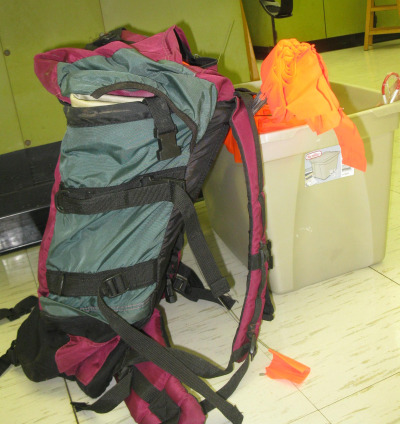What makes a good field pack?
[Cross posted at Highly Allochthonous]
Adding to the meme begun by Short Geologist (requirements for a field hotel) and followed on by Maria (requirements for a field vehicle), I’ll present my requirements for a field pack. The topic has been on my mind a bit recently because I’m launching a new project this summer and will be spending a non-trivial portion of the summer swatting mosquitoes, avoiding snakes, and collecting data.
When I go in the field, I generally go for a 6-10 hour day, departing from home, field station, or campsite and field vehicle. For me, field work has consisted of two basic types of tasks: (1) collecting samples in the field and lugging it home; and (2) downloading data from field instrumentation, with limited sample collection. As someone interested in how water interacts with the geology and the landscape, I’ve lugged rock samples for chemical analysis, hauled kilograms of salt for dilution discharge measurements, and collected thousands of water samples from springs and streams. I’ve also spent a lot of time with a backpack loaded with a lap-top and hip waders, for days when I need to download data from temperature probes and water height recorders. Occasionally I’ll have field days where I have to lug a bunch of awkwardly shaped stuff into the field in order to set up instrumentation, but I really haven’t found any graceful or systematic way of doing that. A rough estimate would be that I spent about one out of four years of my PhD in the field, so I’ve spent a fair bit of time contemplating what works and what doesn’t for field packs. Pictured below is the trusty field pack that seen me through since my undergraduate days.

My two main field tasks would be optimally served by two different packs, so I’ll present their requirements separately below. But there are some key things that all field packs should have.
- A zipper compartment, preferably with clip for my wallet, keys, and cell phone.
- A compartment near the top of the pack for my lunch. I detest squished sandwiches.
- Outside pockets sized appropriately to securely hold my water bottles in easily accessible places
- An easily accessible pocket for a field notebook and writing implement. Maps could go here too. A GPS could go here, but is no substitute for the proper maps.
- Comfortably padded hip and shoulder straps that allow me to carry weight on my hips.
- Various straps and clips for attaching random bits of gear (e.g., rock hammer) to the outside of your pack. These straps and clips should be usefully configured for carrying things and should not just be decorative.
- A place to store the absolutely necessary first aid kit. Don’t leave home without it.
Sample lugging packs should have:
- A big open compartment suitable for dropping things in and not worrying about them until I get back to the vehicle, field station, or lab.
- Sufficient back padding to protect my back from any oddly protruding samples. Anyone who’s hiked miles with a piece of basalt stuck into their mid-back will know just how crucial this is.
- Another compartment (in addition to the list above) to hold rain gear or other protective apparel (e.g., glasses . This compartment should be accessible even when the pack is full of samples, because when the cloudburst starts, you don’t want to spend precious minutes extracting your rain gear from below your samples.
Data download packs should have:
- A padded computer sleeve that holds the computer close to my back and protects the computer on all four sides.
- Numerous compartments to hold various download cords and dongles, flagging, tools, and bits and pieces of repair items for instrumentation.
- A compartment for holding a limited number of samples. This compartment should be smaller than the one described in the sample lugging pack, and could also double as a place to store any portable equipment that I will use in the field. When I collect small water samples, I store them in a small padded lunch box that I slide in and out of my pack. I might also be storing a Marsh-McBirney flow meter here.
My field pack, above, is definitely of the sample lugging variety, but lately I find that most of my work is of the data-download sort. I’m hiking short distances and then collecting small water samples, making field notes, and downloading temperature probes and other loggers. My big field pack isn’t well suited for this sort of work, so I’m the market for a second field pack. I’m hopeful that REI (or the local outfitter of choice) will be able to supply me with a pack that meets my requirements. I’m also curious to know what things other people look for in field packs. Is the ideal field pack the same for a hydrogeologist as a volcanologist or paleo-seismologist? I’m not a vest-wearer. For those who wear field vests, how does that change what you look for in a pack?
